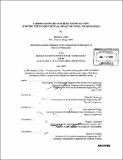Carbon nanotube synthesis and detection : limiting the environmental impact of novel technologies
Author(s)
Plata, Desirée L
DownloadFull printable version (55.94Mb)
Alternative title
Limiting the environmental impact of novel technologies
Other Contributors
Woods Hole Oceanographic Institution.
Advisor
Philip M. Gschwend and Christopher M. Reddy.
Terms of use
Metadata
Show full item recordAbstract
Driven by commercial promise, the carbon nanotube (CNT) industry is growing rapidly, yet little is known about the potential environmental impacts of these novel materials. In particular, there are no methods to detect CNTs in environmental matrices (e.g.,sediment) and thus, there is no way to study their transport or gauge ecological exposure. Thermal methods were developed to quantify CNTs in coastal sediments down to 10 ug per sample, which is sufficient to for CNTs in laboratory air, but not sufficient to measure contemporary levels of CNTs in the environment (which were estimated to be present at pg g' sediment levels using a dynamic mass balance model). In addition to the CNTs themselves, potential impacts of CNT production were assessed by monitoring emissions from a representative synthesis. An ethene-fed chemical vapor deposition process generated several compounds of environmental concern, including the greenhouse gas, methane, the hazardous pollutants, benzene and 1,3-butadiene, and toxic polycyclic aromatic hydrocarbons. By identifying critical CNT precursors (alkynes), I delivered these compounds without thermal pre-treatment and achieved rapid CNT growth. This approach reduced carbonaceous emissions by more than an order of magnitude, and lowered initial feedstock requirements and energetic demands by at least 20%, without sacrificing CNT yield.
Description
Thesis (Ph. D.)--Joint Program in Oceanography/Applied Ocean Science and Engineering (Massachusetts Institute of Technology, Dept. of Civil and Environmental Engineering; and the Woods Hole Oceanographic Institution), 2009. Includes bibliographical references.
Date issued
2009Department
Joint Program in Oceanography/Applied Ocean Science and Engineering; Woods Hole Oceanographic Institution; Massachusetts Institute of Technology. Department of Civil and Environmental EngineeringPublisher
Massachusetts Institute of Technology
Keywords
Joint Program in Oceanography/Applied Ocean Science and Engineering., Civil and Environmental Engineering., Woods Hole Oceanographic Institution.